An argument for reusable PPE
“Do you want to come in?” the resident physician asked me as she held out one of the many blue plastic gowns. “No thank you, I don’t want to waste plastic. Suit yourself,” she replied.
She joined the team in unraveling the plastic gowns they donned with gloves and a face mask before quickly entering the patient’s room. I stood outside and waited for three minutes before they returned, swiftly ripping off their plastic gowns, gloves, and paper masks and throwing them all in the trash.
“So much waste for a three-minute encounter,” I thought to myself imagining the hundreds of pounds of plastic and paper waste produced by hospital personal protective equipment (PPE) every day.
During the current coronavirus pandemic, supplies are dwindling. We put healthcare professionals at risk by encouraging them to forfeit their own safety to care for patients without the necessary protection, or we put patients at risk by avoiding patient contact.

Several institutions have emphasized not to disinfect masks in home ovens. In some cases, healthcare professionals have had to use bandanas and homemade masks to fill the scarcity. I can’t help but wonder – why at this point have we not developed a technology to disinfect masks, gowns, and gloves in the hospital?
The COVID-19 pandemic and its resulting PPE crisis make it very clear – we as a medical community have an unnecessary and dangerous reliance on disposable equipment and need to focus instead on reusable options.
The main concerns with reusable PPE are the upfront cost of purchasing a hospital’s worth of reusable PPE, availability of technology, and effectiveness of sterilization procedures.
With more advanced technology and reliable materials, reusable PPE would likely cost more to purchase; however, having a full set of reusable PPE means no longer spending large amounts daily on the disposable standard.
Furthermore, reusable PPE reduces natural resource energy consumption, greenhouse gas emissions, total water consumption, and solid waste generation. Cost saved in energy resources in the long run makes up for the upfront cost of purchasing the reusable materials with the added benefit of protecting our planet and its resources.
It is critical for reusable PPE to be properly sterilized and tested to ensure it appropriately prevents infection. This is not an easy task. For example, creating reusable respirators poses a unique challenge as many of the materials used are destroyed during typical sterilization processes.
A recent study found that reusable elastometric half-mask respirators (as used in manufacturing and construction) rivaled N95 respirators in performance and fit testing with concerns still apparent for appropriate sterilization methods.
Within the last month, the FDA approved the Battelle Critical Care Decontamination System as a method to decontaminate single-use PPE. While this is not a replacement for the development of PPE meant for multiple uses, it is a promising decontamination solution. Now more than ever we can and should prioritize developing and implementing reusable PPE and decontamination technology.
From an administrative standpoint, sterilizing a hospital’s worth of PPE during a pandemic can save time and money with high upfront costs but long-term financial benefit. From a patient standpoint, it can save lives amid pandemics by providing a regularly replenished stream of PPE. From an environmental standpoint, it would dramatically improve our overall environmental awareness.
It is time hospitals take responsibility and demand the innovative implementation of reusable PPE for the sake of our patients, our providers, and the betterment of our planet.
–By Maria Alejandra Jaramillo, a third-year medical student at Baylor College of Medicine



